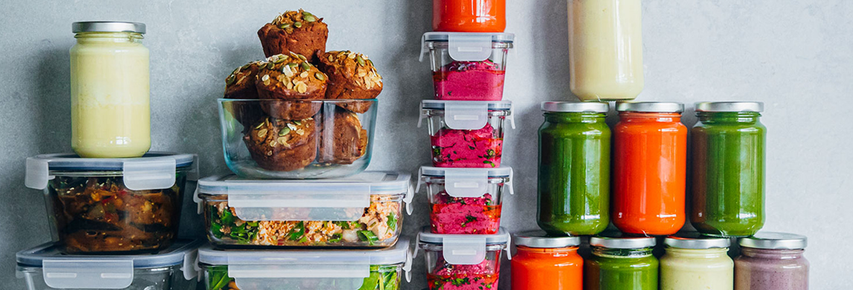_(1)_(1).jpg?width=525&height=350&format=jpg&quality=95)
Food in focus: A guide to rice
Rice has been a staple in many cultures for thousands of years, and is a much loved grain in New Zealand. From fried rice to risotto to accompanying a tasty stir-fry, rice is incredibly popular due to its versatility and affordability, but sometimes it gets a bad health rap. With so many varieties, it’s hard to know which to choose.
Let’s start at the beginning - what is rice?
Rice has been grown for food for more than 8,000 years and is a staple for more than half of the world’s population making it an important form of sustenance. Without it, many people around the world would go hungry. Rice is actually a cereal, related to other cereal grass plants like wheat, oats and barley. Plain rice, in all its various forms, is naturally gluten free.
Typically boiled or steamed, this cost-effective grain can also be ground into a gluten free flour or used to make an alternate milk or syrup.
There are more than 40,000 varieties of cultivated rice growing in all different colours and sizes but they are mostly categorised into two groups by shape – long or short grain, and by colour - white or brown.
What is the difference between white and brown rice?
White rice has had the fibre-rich outer bran of the grain removed along with the nutrient-rich germ. This gives it a longer shelf life, reduces cooking time and has a neutral flavour. This process means it has less fibre and protein than the brown, wholegrain version.
Brown rice, on the other hand, retains both the bran and the germ making it nutrient rich and has more of a nutty flavour. It does however take slightly longer to cook.
So, is rice healthy? What are the health benefits?
Yes! Rice is a brilliant grain. Rice mainly contains carbohydrate with some protein and virtually no fat or sugar. It is a source of fibre, with brown rice containing far more than white.
Both white and brown rice contain varying amounts of soluble fibre called resistant starch which acts as a prebiotic to feed good gut bacteria. Cooking and then cooling rice can also increase the amount of resistant starch - another great reason to add delicious rice salads to the menu this BBQ season!
The grain (particularly brown rice) is rich in several vitamins and minerals including vitamin B1, vitamin B6, magnesium, phosphorus, selenium and manganese. Rice with shades of red and purple are known to possess high levels of beneficial bioactive compounds.
Rice is also gluten free, so is a great choice for people with Coeliac disease or gluten sensitivity.
Which variety should I choose?
With so many varieties, it can be difficult to know the best one to choose. To get the most nutrition bang for your buck, opt for wholegrain choices like brown, red, black or purple rice. Eating more wholegrains is one of the best things you can do for your health, and making the switch from white rice to a wholegrain variety is one easy way to get more wholegrains into your diet.
Struggling to get your kids to try wholegrain rice? Try a 50:50 mix of brown and white rice. Because the brown rice takes longer to cook, start by cooking the brown rice before adding your white rice.
If your recipe calls for white rice, look for options with a lower GI varieties as they can help you to better control your blood glucose.
Now, let’s look at the 4 most common types of rice and what they are used for:
- Long Grain White Rice – Mild in flavour, fluffing up nicely when cooked while staying slightly sticky – it is a great all-rounder. There are also low GI varieties available like Doongara rice.
- Basmati – Considered an aromatic rice due to its slightly floral fragrance and flavour. It is fluffy when cooked, but slightly dry making it perfect for pilaffs or as a side. It is most commonly used in Indian cooking. It comes in both brown and white varieties. Basmati rice also tends to have a lower GI than other varieties.
- Jasmine – Also an aromatic rice due to its slightly nutty flavour and aroma. It is fluffy when cooked, while remaining slightly sticky. It is commonly used in Chinese, Thai and other Southeast Asian cuisines.
- Arborio – A short grain white rice that is high in starch, allowing it to absorb more liquid and become sticky. It is usually used for making the Italian dish risotto.
Brown rice – Technically all rice starts as ‘brown rice’ so it can come in any size grain, but it is most commonly found in long grain form. Brown rice has a firmer chewier texture and a nuttier flavour than white rice. It is a great versatile, nutrient-rich rice to choose.
How to cook the perfect brown rice
The key for cooking brown rice successfully is to use the right ratio of water to rice – try doubling the amount of water to rice. After cooking allow it to stand to absorb any remaining moisture. To give you perfectly tender grains. Try for yourself in this caramelised onion and kale rice.
If you don’t have the extra time to cook brown rice, try cooking it in a pressure cooker. And do yourself a favour and do a double batch, freezing half for next time – your future self will thank you.
Answers to your commonly asked rice questions
- Can I freeze rice after cooking? Yes, you can. The trick is to cool it as quickly as possible in a shallow container in the fridge. Then portion the rice out, label and freeze for up to 1 month. Thaw it in the fridge and use within one day.
- How long can I store rice in the fridge? Cooked rice can be stored in the fridge for 5 days. Storing it any longer increases the risk of food poisoning bacteria to be present and if eaten, could make you sick.
Should I rinse rice before cooking? There have reports of arsenic being present in rice from the growing process. The risk of this can be reduced by up to 57% by washing and cooking the rice in clean water.
Need some rice inspiration?
Try these simple and affordable rice recipes:
- Coconut brown rice – a unique and tasty spin on the traditional rice side dish
Oven baked veg fried rice with crispy tofu – a quick and easy take on wok fried rice developed by Sneh Roy from @cookrepublic
Spinach quiche with brown rice crust – this clever rice crusted quiche is a fantastic way to use up any leftover rice.
Berry rice pudding – this rice pudding recipe shows that rice can be a staple at breakfast and dessert too.

The latest nutrition advice, plus health and wellness tips delivered to your inbox monthly

